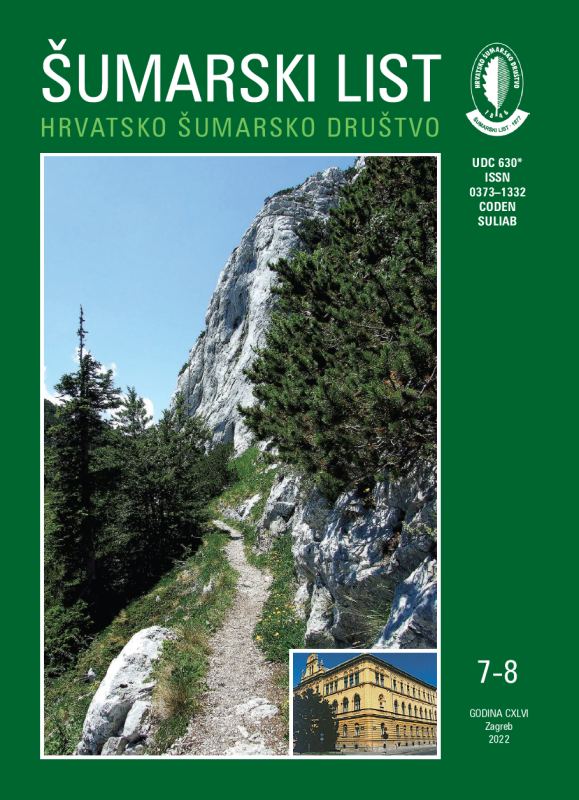
broj: 7-8/2022
pdf (12,97 MB) |
|
||||||||||||||
| RIJEČ UREDNIŠTVA | ||
| Uredništvo | ||
| Why do we lag behind in the green transition and energy independence? pdf HR EN | 281 | |
| IZVORNI ZNANSTVENI ČLANCI | ||
| Damir Ugarković, Ivica Tikvić, Ivana Grgurić, Ivan Perković, Nataša Hulak, Vibor Roje, Petar Šutalo, Krešimir Popić | UDK 630* 114.7 (001) https://doi.org/10.31298/sl.146.7-8.1 | |
| Enzymatic activity of forest soil in damaged forest ecosystem of silver fir with hard fern pdf HR EN | 283 | |
| Krunoslav Sever, Antonia Vukmirović, Luka Hodak, Saša Bogdan, Ida Katičić Bogdan, Daniel Krstonošić, Tomislav Karažija, Jozo Franjić, Željko Škvorc | UDK 630*231 + 233 (001) https://doi.org/10.31298/sl.146.7-8.2 | |
| Functional adaptation of natural sessile oak and common beech saplings on different habitat conditions pdf HR EN | 293 | |
| Summary The aim of this study was to examine the influence of climatic and edaphic conditions in two mixed stands (provenances) of common beech and sessile oak from eastern (Slavonski Brod - SB provenence) and northwestern (Karlovac - KA provenence) Croatia on the functional adaptation of growth and dry matter production of their natural saplings. The main differences between the provenances with regard to climatic conditions is reflected in the amount of precipitation. The amount of precipitation in the area of KA provenance is much higher than in the area of SB provenance (Table 1 and 2). In spite of, due to the unfavorable distribution of precipitation during the growth of the investigated saplings in the period 2016 – 2020, dry periods were more frequent in the KA provenance than in the SB provenance (Figure 1). Edaphic conditions (physical and chemical soil traits), did not significantly differ between the provenances. However, the soil of KA provenance was characterized by a slightly lighter structure (less clay and more skeletons) compared to the soil of SB provenance (Table 3 – 5 and Figure 2). Differences in growth and dry matter production, as well as in allometric growth relations between provenances and species were examined using two-way ANOVA. The obtained results indicate that the saplings from the KA provenance compared to the saplings from the SB provenance invested more dry matter in root growth (especially fine roots) and took root deeper. In addition, the saplings from the KA provenance developed a thicker and lower stem compared to the saplings from the SB provenance (Table 6 – 8). This indicates that the saplings from the KA provenance are functionally more adapted to the drought habitat. It could be the result of differently manifested phenotypic modification (drought response) and/or real genetic differences between provenances, which our research could not distinguish more accurately. The obtained differences in the growth and dry matter production between the sessile oak and the common beech saplings correspond to the already known patterns of their functional adaptation to the habitat humidity. It means that sessile oak saplings took deeper roots and invested more dry matter in the coarse roots compared to common beech saplings that took root more shallowly and invested more dry matter in the fine roots (Table 9). Key words: Quercus petraea L.; Fagus sylvatica L.; drought; alometric growth relations; dry matter; fine roots; coarse roots; stem | ||
| Vladan Popović, Darka Šešlija Jovanović, Aleksandar Lučić, Ljubinko Rakonjac, Sanja Jovanović, Aleksandar Vasiljević, Danijela Miljković | UDK 630* 164 (001) https://doi.org/10.31298/sl.146.7-8.3 | |
| Spatial variation of morphological needle traits of silver fir (Abies alba Mill.) populations in the Balkan peninsula in relation to climatic factors pdf HR EN | 309 | |
| Vojislav Dukić, Miroslav Mirković, Branko Stajić, Danijela Petrović, Marko Kazimirović, Srđan Bilić | UDK 630* 111.8 (001) https://doi.org/10.31298/sl.146.7-8.4 | |
| Comparative analysis of the influence of climate factors on the radial growth of autochthonous pine species (Pinus spp.) in central Bosnia and Herzegovina pdf HR EN | 319 | |
| Abdullah E. Akay, H. Hulusi Acar, Buse Kalkan | UDK 630*907.1 (001) https://doi.org/10.31298/sl.146.7-8.5 | |
| Using GIS techniques for modeling of anthropogenic noise propagation generated by a chainsaw in forest harvesting pdf HR EN | 333 | |
| Alptug Sari | UDK 630*156 (001) https://doi.org/10.31298/sl.146.7-8.6 | |
| Maximum Entropy Niche-Based Predicting of Potential Habitat for the Anatolian Leopard (Panthera pardus tulliana Valenciennes, 1856) in Türkiye pdf HR EN | 345 | |


